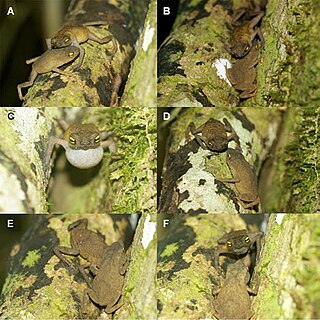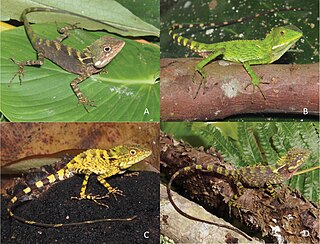Cnemaspis is a genus of diurnal (day) geckos found in Asia. With over 100 species, it is one of the most diverse genera of geckos. Molecular phylogenies suggest that the two regional groupings may form distinct clades which are not each other's closest relatives.

Pseudocalotes is a genus of agamid lizards endemic to Southeast Asia.

Eastern spadefoot toads comprise a genus of the family Megophryidae in the order Anura, and are found in southern China, northeast India, southeast Asia, and islands of the Sunda Shelf as well as the Philippines. They are characterized by a stocky body with slender, short hindlimbs. In identifying species, iris colour is a valuable diagnostic morphological characteristic ; the iris has uniform colour in some species, whereas in other species the upper half is coloured and the lower half is dark.

Philautus is a genus of shrub frogs in the family Rhacophoridae from Asia. Some species in this genus are now considered extinct by IUCN, while others are widespread and abundant. The taxonomy of the group is unclear, with many poorly described species.

Occidozyga is a genus of frogs in the family Dicroglossidae found in southeastern Asia between eastern India, southern China, and Java. They sometimes go under the common name Java frogs or floating frogs.

Frostius pernambucensis, or the Frost's toad, is a species of toad in the family Bufonidae. It is endemic to the eastern Brazil where it is known from the Paraíba, Pernambuco, Alagoas, and eastern Bahia states.

Micryletta erythropoda, commonly known as the Mada paddy frog, is a species of frog in the family Microhylidae. It is known from Myanmar, Thailand, and Vietnam. Its natural habitats are swamps, freshwater marshes, and intermittent freshwater marshes. While formerly classified in the genus Microhyla, a 2018 study found it to belong to the genus Micryletta instead. A study performed in 2019 found that several Micryletta populations in southern Myanmar and Thailand that were formerly assigned to M. inornata actually belong to M. erythropoda; prior to this, M. erythropoda was considered endemic to Vietnam.
Rhacophorus poecilonotus, also known as the Sumatra flying frog, is a species of frog in the family Rhacophoridae. It is endemic to Sumatra, Indonesia.
Djoko Tjahjono Iskandar is an Indonesian herpetologist who studies the amphibians of Southeast Asia and Australasia. He is a professor of biosystematics and ecology at Bandung Institute of Technology in West Java, Indonesia.

Incilius is genus of toads in the true toad family, Bufonidae. They are sometimes known as the Central American toads or Middle American toads and are found in southern USA, Mexico, Central America, and northern Pacific South America. They are an ecologically and biogeographically diverse group of toads, including micro-endemic species such as Incilius spiculatus that are restricted to undisturbed cloud forests, and widespread lowland species such as Incilius valliceps that predominantly occur in disturbed habitats.
Lycodon sidiki is one of seven Sunda Shelf species of snakes in the family Colubridae. It is endemic to Aceh Province, Sumatra.
Cnemaspis purnamai is a species of geckos endemic to Belitung Island in Indonesia.

Lophocalotes is a genus of lizards in the family Agamidae. The genus, which is endemic to Sumatra, contains two species.
Lophocalotes achlios, also known commonly as the white-throated crested dragon, is a species of lizard in the family Agamidae. The species is endemic to Sumatra, Indonesia

Dendragama is a genus of lizards in the family Agamidae. The genus is endemic to the Barisan Mountains in Sumatra (Indonesia) and is typically found at altitudes above 1,500 m (4,900 ft). Populations of Dendragama were discovered at the northern and southern ends of Sumatra. High genetic distances and concordance of multiple, apparently independent diagnostic characters support the descriptions of these two populations as new species. These species undergo remarkable color change in response to time of day and stress.
Dendragama australis is a species of lizard in the family Agamidae. It is endemic to Sumatra.
Dendragama dioidema is a species of lizard in the family Agamidae. It is endemic to Sumatra.

Dendragama schneideri, Schneider's tree agama, is a species of lizard in the family Agamidae. It is endemic to Sumatra.

Pelobatrachus is a genus of frogs in the family Megophryidae. It was formerly synonymized with Megophrys until 2021, when it was revived as a distinct genus. They inhabit Southeast Asia, namely the Malay Peninsula, Sumatra, Borneo and the Philippines. Their common name is clay horned toads.










